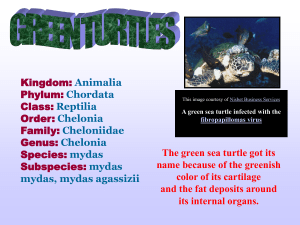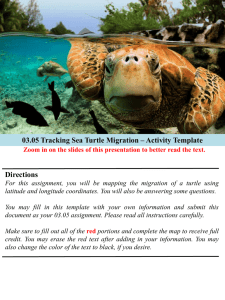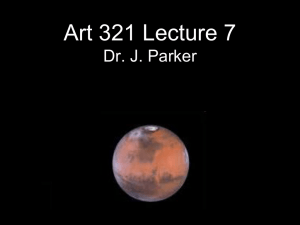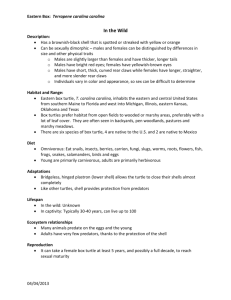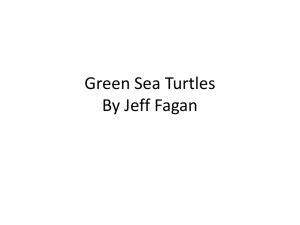2015 Maabayj Turtle Camp Report - Sonya Fenton
advertisement
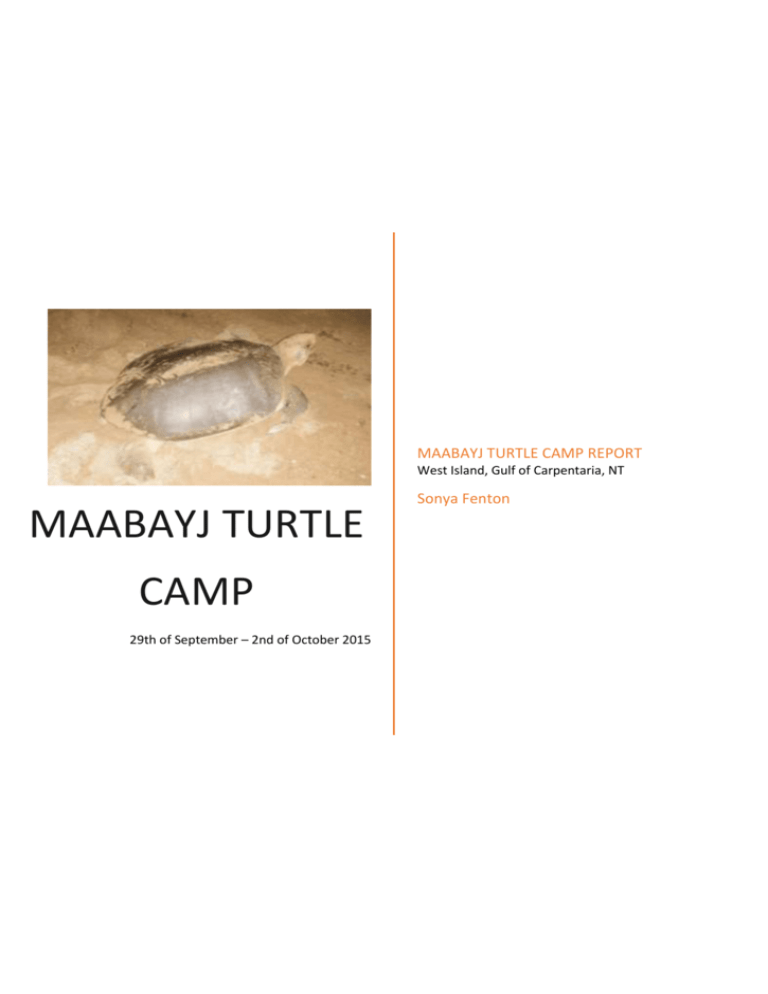
MAABAYJ TURTLE CAMP REPORT West Island, Gulf of Carpentaria, NT MAABAYJ TURTLE CAMP 29th of September – 2nd of October 2015 Sonya Fenton Introduction I was fortunate enough to be offered Ethos Global’s Turtle Camp sponsorship, which allowed me to attend the Narnu-Yuwa Ki Wundunyukuwa Maabayj Turtle Camp lead by the Li-Anthawirriyarra Sea Ranger unit. Ethos global are involved with multiple indigenous community projects, including the Turtle Camp sponsorship. I would like to thank Ethos Global for this opportunity to explore the ecology and culture of West Island and surrounding areas. I would also like to express my appreciation for the Sea Ranger unit, the staff and the traditional owners of the island, for their hospitality and for allowing me to learn and discover the ecology and culture of the land. The Maabayj Turtle Camp was an excellent experience. Positioned amongst the Sir Edward Pellew group in the Gulf of Carpenteria, West Island is located off the coast of Borroloola. A 30-40 minute barge ride will take you from the coast of Borroloola (Bing Bong Port) to Maabayj Beach, on the north part of West Island. The accommodation and camping area faces the ocean, and a clear horizon. A 2km stretch of sand, near the campsite, is where the sea turtles lay their eggs. The Turtle Camp itself involves outdoor-based activities, primarily sea turtle (wundunyuka) scouting and practical researching. During the day, guests get to enjoy and participate in hand line fishing, finding mud-mussels, swimming, boating and getting to know the locals and other tourists. Cultural activities are also included; traditional dancing, learning about the history of the land, dreamtime stories and weaving. During the night-time, the rangers search for signs of sea turtles, then invite guests to observe the laying of the eggs and/or hatchlings of, primarily, Wirndiwirndi, (flatback turtles). I am producing this report to share my experience and what I have learnt. Turtle Research In order to locate emerging turtles, rangers divided the beach into different sectors, allocating families and rangers to each sector. The key is to look for the turtle’s distinctive track and follow them until they begin their nesting and laying process. Once the sea turtle finds a position, they begin a lengthy process of hollowing out a nest in the sand. First, the turtle imprints its body into the sand, while slightly rotating, (similar to making snow angles – but sand angles) then they clear out sand below them, creating the burrow for the eggs. It is a complicated and intricate process, which can take up to an hour, and is tiring for the turtle. It requires the turtle to use one leg to clear the sand away, and another to pack the sand against the wall. Once the burrow is prepped, the turtle begins to lay the eggs, which appear as leathery golf balls. It will take a couple of weeks before the eggs hatch, permitting favouring conditions. Figure 1 - Tagging the Turtle When the turtle retreats back to sea, after laying, the rangers being to conduct their research. This includes; -Checking tags and identification -Tagging/microchipping if not done already -Observing nesting tendencies -Measuring the carapace of the turtle (top area of the turtle) -Measuring the weight of hatchlings and eggs Life on the Island Spending three days on an island was an escape from the typical Darwin life. If there is one thing I’ve learnt, it’s that simplicity is luxury. On the Island, you don’t need clocks or phones to tell the time, you go by the tide, and you don’t need to worry about waking up on time either, the sun will do that for you. Dinner could be as simple as some freshly hand-lined caught fish and damper, cooked on an open fire. Also, no air-con is necessary when the ocean is right outside your eco-tent. There was something so refreshing about being able to experience what feels like a whole new world, to have people share their experiences with you and share their way of life with you. I spoke to the children to see if they knew how lucky they were to have such a beautiful island to visit. To them, it was a normal holiday, visiting West Island was a chance to visit family and have some fun. Nora explained that this was her go-to holiday; “I come here a lot, to see everybody and so I can visit the turtles”. I asked a few of the kids what they knew about turtles and the land, and I have to say, they were some of the most educated young children I have ever met. They were able to tell me about why the turtles come up onto Maabayj Beach and explained how turtles lay their eggs. It’s incredible that these children are exposed to such pure and natural experiences, and so intouch with their history and culture. The rangers were interesting to converse with as well, especially Ronnie. Ronnie explained that he had been living around the Borroloola area since he was born, and that he got to watch the McArthur River Mines develop into what they are today. As we travelled the roads, he pointed out land-marks and animals, and it felt like he knew everything about everything. I even got to learn about their issues with feral animals, such as donkeys and pigs. Jodie, the visitor coordinator, taught me a lot about the (I guess you could say political) side of her culture. Jodie was explaining that often tourists (not visiting Turtle Camp) will fish around West Island without permission, which is really an infringement on cultural rights. Jodie expressed that she/they did not have an issue with them fishing, but rather an issue that they do not ask for permission, which seems to be a fair compromise. Jodie also spoke about how different rocks originated and came to be positioned on the land, but that she could not show us the rocks within the next 10 years, as someone had passed away, and keeping those areas private was a matter of respect. The Elders, of course, were very wise and knew a lot about utilising the land; using pandanus for weaving things like baskets, is just one example. Although, I will admit it is difficult to master the technique of preparing the pandanus leaves, and takes time to master. The Elders also shared stories and songs which have been passed down for generations. It was things like these that made me understand that the Indigenous people’s care and love for the land; their culture and history, and that in itself, was a special moment of realisation and understanding for me. Daily Breakdown Tuesday 29th September I arrived at the McArthur River Mine Airport at approximately 7am, where a ranger, Ronnie, picked me up and drove an hour out to Bing Bong Port, just past Borroloola. From the port, I boarded barge with some of the locals and sea rangers. a On the barge I met a Canadian family residing in Brisbane, a young NT family and a few sea rangers like Sean. When I arrived at Maabayj Beach, West Figure 2 - The Barge, on our way to West Island Island, I was kindly greeted by some local children and staff members. Eco-tents were the luxury accommodation for visitors, furnished with a bed, table and a beautiful view. At around noon, after a delicious lunch, we were transported inland, towards the creeks and waterways, via a quad bike and trailer! First, using particular netting techniques, we collected small fish for bait, then we used hand lines to fish in the creek. Unfortunately, the fish were a bit too cunning for me, and stole my bait, leaving me only to be eaten by the mossies. However, a few others managed to catch some small fish, but my guess is that it was all “luck”. We also went searching for mud mussels; Figure 3 - On our way to the creek for a fish, via the Quad Bike and Trailer they can be found by looking for a mouth-like shape protruding through the mud. When arriving back to the campsite for rehydration and rest, I decided to swim and meet some of the children. A couple young girls befriended me while warning about the sharks and jelly fish. I must admit, it felt so nice to swim in salt water, considering I don’t swim in Darwin. of me Figure 4 - Prefect Place to Swim We had a fire that night, where they were cooking the mud mussels we found earlier in the day. I was hesitant to try one, considering I dislike normal mussels, but I was assured it was a popular choice among the locals. It was much larger in size than a regular mussel, had a strong salty taste, and was extremely chewy. I think it’s safe to say, I was chewing the mussel for about 15 minutes. Figure 5 Mud Mussel Just before night fell, everyone gathered around to watch a few animations, which described how the land came to be what it is today. The first one was about the sea turtles, and was rather violent. This was eventually interrupted, though, as the Rangers had located the first turtle of the night. We travelled to the site of where the turtle had begun preparing to lay, noticing that it was a flat back sea turtle and that the turtle’s back leg was missing. I learnt that because sea turtles have a precise digging technique, this turtle was struggling to dig a burrow for its eggs, so eventually left to retreat back to the ocean. Sea ranger, Sean, explained that the turtle can decide when to lay, and that it is not like human birth where you go into labour, but that this turtle would continue to have difficulties digging and therefore will delay laying. There were a few more turtles throughout the night, where I witnessed two turtles create the sandy nest and lay their eggs! I was fortunate enough to see a hatchling, on the first night, as well. Some girls and I got to dig in the sand to find the remaining hatchling(s) that hadn’t gone to sea yet. We found one, and it was about the size of my palm! (Unfortunately I did not get a photo!) When the clock hit 10, I decided to head off to bed, since I had an early flight and long day. I had already learnt so much, and was pretty impressed that I had seen a hatchling on my first night! Wednesday 30th September I woke up at about 7 o’clock to a hot breakfast of eggs, toast and bacon, and the company of the other tourists. The Canadian family and I were able to go out on the boat to do some more fishing. I got along with Cameron well, since we both enjoyed science and rock climbing. The ocean was so pretty, I saw jelly fish and sea turtles and everything was just so natural and pure, even the smell of the sea. Speaking of natural, the sea rangers were naturals when it came to fishing, they caught a fish nearly every time they threw their line out. At one stage Sean was battling with a surfacedweller for about 10 minutes, before he was forced to cut his line; he thinks it may have been a sting ray. I, on the other hand, Figure 6-Fish we caught did manage to catch a shark, but we set him free. I also caught the rare, native and exotic… boat propeller. I don’t know if my technique was wrong, but I do feel like something fishy was going on. When we got back, we had a few hours to relax, so I sat outside my tent and did some writing and photography. I was joined by Erin, a tourist, where we got talking about travel, school and history. Erin was such an interesting person to converse with, having had so much experience in travel. In the afternoon, the older ladies taught us basket weaving, using pandanas leaves. I mostly prepped the leaves by removing the spikes and peeling layers, then the Elders used them to start weaving a basket. Figure 7 - Traditional Dancing Into the night, unfortunately there were no turtles until very early in the morning. But, we did get to enjoy dream time stories, songs and the traditional dances that accompanied them, around a bon fire. After a while, I got to join in and have the kids teach me how to do some of the dances. I’m still not sure if they were laughing because they were having fun, or because I tripped over my own feet. Thursday 1st October I woke up at 7 again, to enjoy their breakfast one last time, and conversed with the rangers and locals, until it was time to leave the island. I boarded the barge and watched the island disappear into the horizon, until I was back at Bing Bong Port. More Pictures Figure 8 - The last night's bonfire Figure 9 - View from my eco-tent! Figure 10 - The Sunset! Figure 11 - Sand Dollars were very abundant on Maabayj Figure 12 - Kids playing before dinner Figure 13 - Swimming was very popular! Figure 14 – Flat Back Turtle being gently restrained for research Turtle Camp was such a unique opportunity for me to explore the Indigenous culture and to learn about turtles and ecology. I would recommend for students to apply for the Ethos Global Sponsorship, especially if it seems like it’s something out of their comfort zone. For me, I love travelling, getting to know new people and trying new things which is why I applied, but I had never done anything like this before. It was the fact that experience was so different and unique, which made it so much more exciting!




